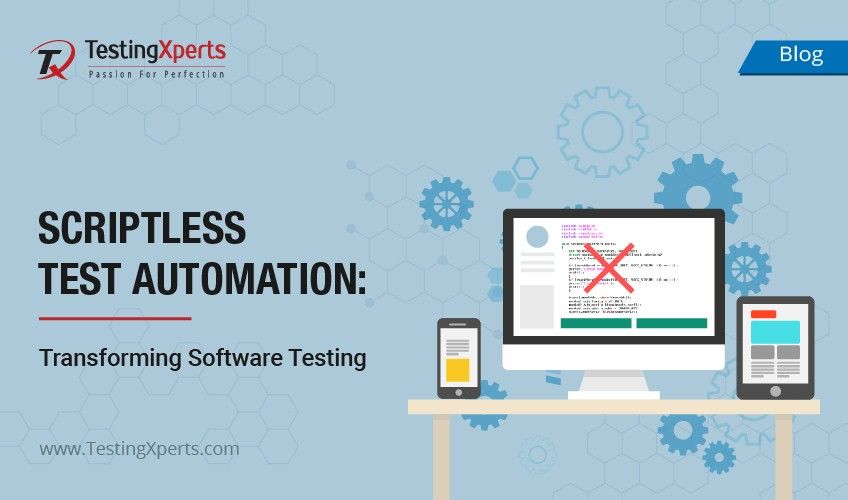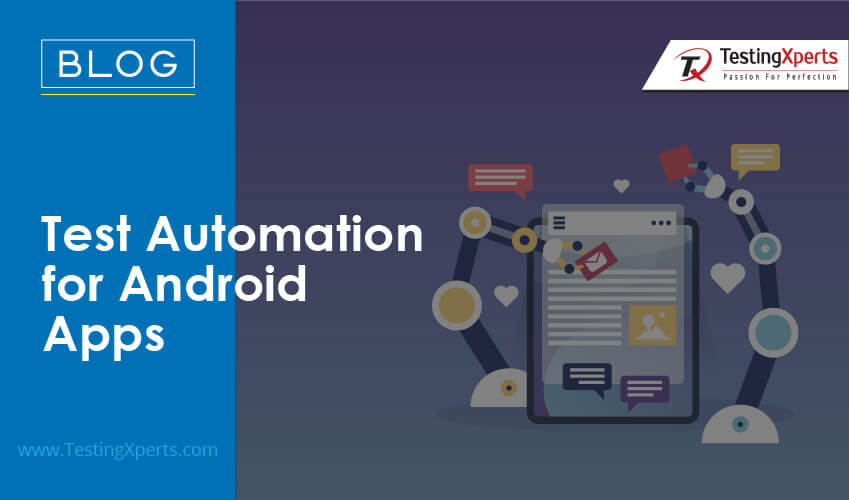
In recent years, there were several changes in the world of technology. The same has
happened in the software testing world where Test Automation has evolved to facilitate rapid software releases at the highest quality.
Contents
1. Challenges Involved with Automation in Testing
2. Scriptless Test Automation
3. Benefits of Scriptless Test Automation
4. Conclusion
Automation has always been interesting, as it reduces the mundane testing efforts and accelerates the testing process. These days, almost every organization is automating test cases. However, the ROI is not always well anticipated. Often, the tools are blamed for the negative ROI, yet the real reason associated with failed test automation are the long hours required to create the test automation suite, the need for specialized development resources, the difficulty of scripting and maintenance, the lack of test data management strategy, and a lack of involvement of the subject matter experts.
Challenges Involved with Automation in Testing
Traditional test automation techniques sometimes turn out to be ineffective in meeting the business demands of rapid application delivery and quicker time-to-market, resulting in a new set of challenges. Here are some of the main test automation challenges.
– Lack of quicker feedback:
In traditional QA methods, the scripts are developed only after the application is built and stabilized. Early feedback, which is essential for the reduction of the cost of quality in Agile development, is thus rarely available.
– Substantial upfront investment:
Large upfront investments are needed due to complex scripting environments and tools, also large investments are needed for test infrastructure, and hiring and training of skilled resources.
– Maintenance issues:
Considering that development teams are increasingly reliant on process automation, automation components need to transform regularly and consistently in response to changes in the application under test. The subsequent expenses arising in maintaining these scripts take away the advantages that automation can bring.
– Change of focus:
The prime objective of the testing team has moved from testing the functionality of the application to the technical development and execution of scripts.
Minimum stakeholder contribution: In conclusion, the key holdups in adopting traditional QA methods are the issues faced by functional and business teams in understanding automation scripts. Extra effort is required to make them available to non-technical users, leading to reduced collaboration between the functional specialists and automation teams.
Related: 6 Recommendations for Driving Business Value from Test Automation
Scriptless Test Automation
One of the solutions to maximize the scalability of test automation is scriptless test automation. Scriptless test automation enables the testers and business users to automate test cases without worrying about the coding. It helps to achieve faster results and reduces the time expended to understand the code.
With the approach of Scriptless test automation, the complete software development process can speed up. The method allows enterprises to participate in test automation and increases the scope of code reusability. Adopting the scriptless framework, it will ease the development teams to overcome the biggest challenge of spending more time at the script development. Also, the methodology helps to simplify the test automation complexity for enterprises.
This approach for automation will not only help the enterprises to reduce the team’s time and efforts, but it will also ensure to maintain quality and ease in achieving their requirements. The major benefits of scriptless automation are outlined in detail below.
Benefits of Scriptless Test Automation
A catalyst between business analysts and technical experts:
The scriptless nature of the tests enables the participation of business users and serves as a facilitator for communication between business analysts and technical experts. It becomes easier for the business analysts and functional experts to converse and review test cases.
Reduces time to automate efficiently:
The quicker you automate, the earlier you get the desired results. Using scriptless automation, the testing team can automate large test suites rapidly. The speed of delivery, as well as the go-to-market time, improves rapidly. Besides this, it decreases the time spent on automation. This ensures early detection of bugs during the software development lifecycle.
Eradicates technical obligation:
Integrating smarter framework design upfront can eradicate the future costs that arise from augmented script maintenance effort. The technical obligation associated with scripts is therefore eliminated.
Quicker script design and development:
A simple and non-complex test design and development process, along with the instinctive user interface, empowers the quicker development of tests.
Scriptless Test Automation Approach
Scriptless automation is an eccentric testing approach that brings exceptional benefits, such as quality and cost savings, at the initiation of the development phase. This process makes automation simpler and easier, and also allows stakeholders to play an active role during the automation in testing process.
Testers are able to focus on their chief objectives, rather than developing a framework which simply enables quicker testing. Scriptless test automation is, hence, a perfect solution to shift-left which caters to the needs and requirements of Agile testing.
Best Tools for Scriptless Test Automation
1. TestCraft
TestCraft is a test automation framework for continuous and regression testing. In addition to these, it allows monitoring the web applications. It is a revolutionary artificial intelligence (AI) that can automatically overcome any changes in the app and helps the teams with the elimination of cost and maintenance time.
Features:
-The tool automatically gets adjusted to the changes made with the AI algorithm and helps in the reduction of maintenance costs
-It is selenium-based and benefits to integrate and leverage with the modules developed by the community
2. Ranorex Studio
Ranorex Studio is an all-in-one test automation solution for performing end-to-end testing on mobiles, desktops, and web. It is an easy to learn tool for beginners and a powerful tool for experts.
Features:
-The latest release of the tool offers support for all the latest technologies and works efficiently to keep the app fit for future needs
-The tool helps to gain control over tests during execution, helps to improve the user experience with the data-driven testing and much more.
3.ACCELQ
ACCELQ automates web testing and API without any need of writing a single line code. Also, it is the only cloud-based continuous testing platform. For IT teams of any size, ACCELQ is the best choice as it can automate many critical aspects such as planning, designing, execution, and test generation.
Features:
-The tool assures to provide end-to-end validation for API and UI
-It provides quality lifecycle management for manual and test
4. ZeuZ
ZeuZ is an on-premise, cloud-based, AI-supported test-automation platform that supports web, mobile, API, and cloud applications.
Features:
-Powerful cloud-based architecture helping to collaborate and create tests from anywhere
-There is no need to learn syntax or code
– This tool allows creating workflows across different channels
– One simple platform offering all-in-one test practices
5.Robot Framework:
This is an open-source automation framework tool, efficiently known for Acceptance Test Driven Automation, Robotic Process Automation (RPA), and Acceptance Testing.
Features:
-This tool uses easy-to-use tabular test syntax utilizing the keyword-driven testing approach
Conclusion
TestingXperts’ profound knowledge and ability to perform scriptless automation has delivered significant savings in the cost and effort of test design and maintenance for our clients. TestingXperts have achieved a substantial reduction in test design and maintenance efforts that resulted in enhanced quality and provided quicker feedback from automated testing.
Discover more
Get in Touch
Stay Updated
Subscribe for more info




